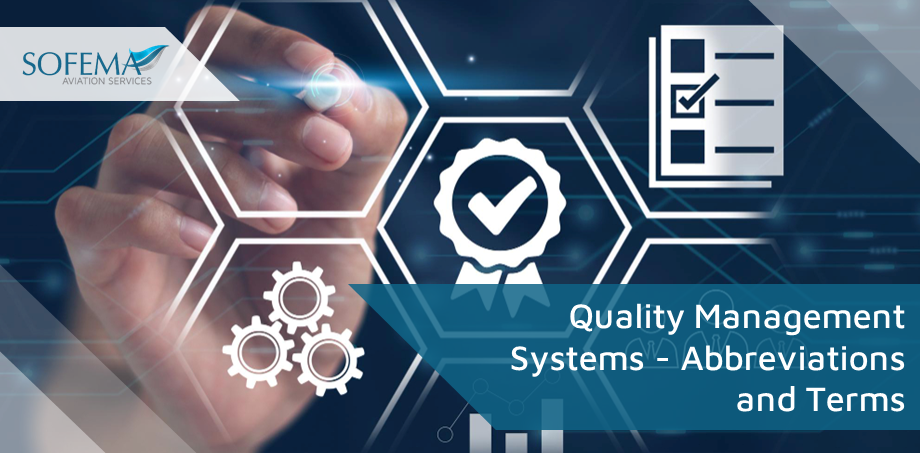Sofema Aviation Services (SAS) www.sassofia.com considers abbreviations and terms in quality management systems.
Quality System
A Quality Management System (QMS) is an integrated framework of business processes that consistently meets organizational and customer requirements and ultimately enhances satisfaction. This system encompasses the organization’s structure, policies, procedures, processes, and resources for implementing quality management.
The primary purposes of a QMS include:
- Improving processes: Streamlining operations to enhance efficiency.
- Reducing waste: Minimizing unnecessary use of resources.
- Lowering costs: Cutting expenses while maintaining quality.
- Facilitating training opportunities: Identifying and addressing skill gaps.
- Engaging staff: Encouraging employee participation and ownership.
- Setting organizational direction: Defining and pursuing strategic goals.
When viewed through the lens of the European Union Aviation Safety Agency (EASA), a QMS is fundamentally about ensuring regulatory compliance.
Quality
Quality is the commitment to meeting the evolving needs of customers, vendors, and employees by offering value-added products and services. This continuous commitment involves education, communication, evaluation, and constant improvement. Consider the following definitions of quality:
- Degree of excellence: Achieving superior standards.
- Conformance to requirements: Meeting specified criteria.
- The totality of characteristics: Combining various attributes to satisfy a need.
- Fitness for use/purpose: Ensuring the product or service is suitable for its intended use.
- Freedom from defects: Providing products that are free of flaws.
- Delighting customers: Exceeding customer expectations.
Accountable Manager
The Accountable Manager is the individual recognized by the authority with the corporate responsibility to ensure that all flight, ground operations, and maintenance activities are financed and executed to the required standards. This role includes overseeing the Quality System (Quality Control and Quality Assurance) and the Safety Management System.
Corrective Action or Discrepancy
Corrective and Preventive Action (CAPA) involves steps to eliminate the causes of an existing nonconformity, defect, or undesirable situation to prevent recurrence. This encompasses actions at various levels, such as manufacturing, documentation, procedures, or systems, to rectify and prevent non-performance.
Quality Audit
A Quality Audit is a systematic and independent examination to verify whether quality activities and related outcomes comply with planned arrangements and if these arrangements are effective and suitable for achieving objectives. Various types of compliance audits include:
- Product Audit: Assessing the final product to ensure it meets specifications.
- Process Audit: Evaluating the processes to verify they are performing as intended.
- System Audit: Checking the overall system for compliance with standards.
- Surveillance Audit: Ongoing monitoring to ensure continued compliance.
Quality Assurance (QA)
Quality Assurance (QA) is a component of quality management focused on providing confidence that quality requirements will be fulfilled. QA involves comparing outcomes with a standard and identifying discrepancies or gaps.
Quality Control (QC)
Quality Control (QC) is how a business ensures product quality is maintained or improved and manufacturing errors are minimized or eliminated. This involves:
- Training personnel
- Establishing benchmarks for product quality
- Testing products to check for significant variations
Quality Improvement
Quality Improvement is a formal approach to analyzing performance and systematically working to enhance it. Various models exist, but the goal remains the same: continuous performance improvement.
Quality Inspection (QI)
Quality Inspection involves checking, measuring, or testing product characteristics to confirm compliance with requirements. Specialized personnel rather than production workers typically carry out this task.
Quality Manager (Compliance Manager)
The Quality Manager, approved by the authority, manages the Quality Assurance System, monitors compliance, and requests remedial actions. Unlike the ISO Quality Manager, the EASA Quality Manager focuses primarily on compliance rather than performance.
Quality Policy
A Quality Policy is a document developed jointly by management and quality experts to express the organization’s quality objectives. It outlines acceptable quality levels and departmental responsibilities to ensure quality, and it is typically a long-term strategic issue.
Quality Surveillance
Quality Surveillance involves random monitoring of activities to verify that procedures, conditions, processes, products, materials, and services conform to specified requirements. This includes observing, measuring, examining, witnessing, and testing, with results compared to predetermined standards.
Management Evaluation
Management Evaluation is a formal review by senior management of the Quality System’s status and adequacy of quality policy and objectives. In an EASA Management System, this evaluation is crucial for the process’s success, with the Quality Manager/Compliance Manager acting as a service provider to the Core Management Team.
Next Steps
Follow this link to our Library to find & download related documents for Free.
Sofema Aviation Services (www.sassofia.com) and Sofemaonline (www.sofemaonline.com) provide EASA Compliant Webinars, Classroom & Online training in over 50 Quality Assurance and Compliance Related Subjects – Please see the websites or email team@sassofia.com
Tags:
Quality Audit, Accountable Manager, Quality, QMS, SAS blogs, Quality Management Systems, Quality Assurance (QA), Quality Control (QC), European Union Aviation Safety Agency (EASA), Corrective Action, Quality Improvement, Quality Inspection (QI), Quality Manager (Compliance Manager), Quality Policy, Management Evaluation, Quality Surveillance





